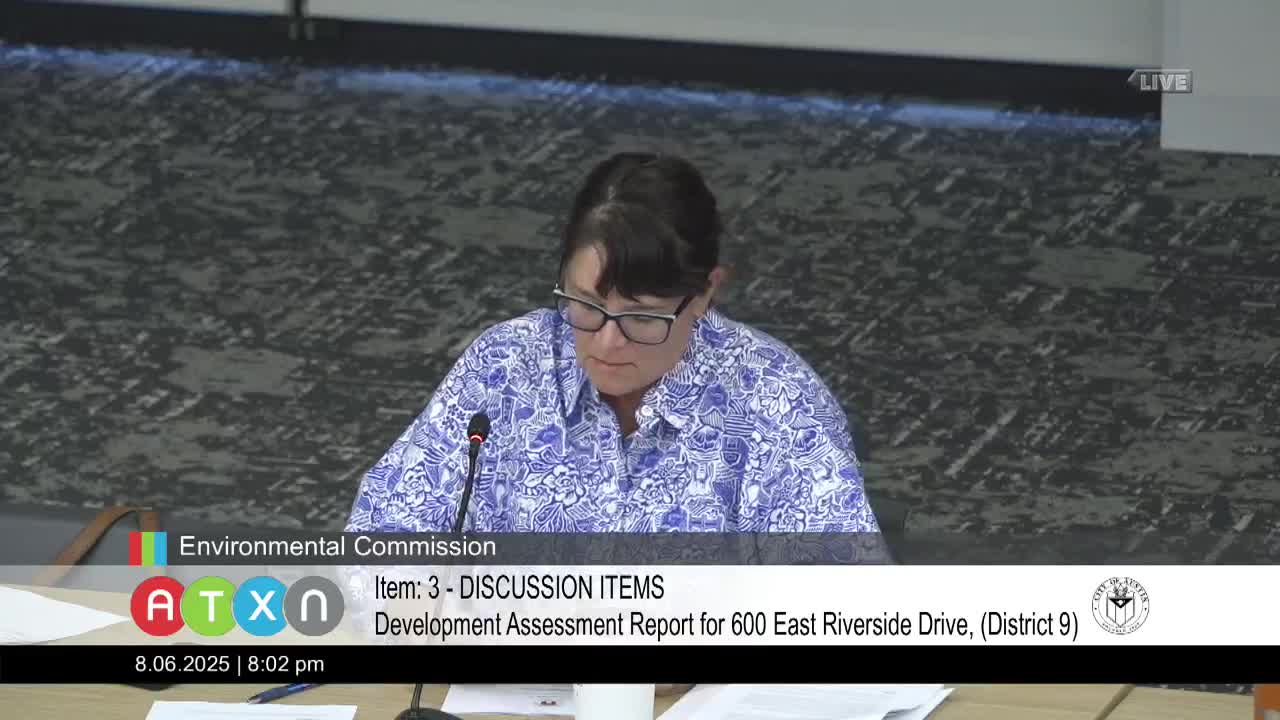Travis Heights Community Advocates for Bird Friendly Design and Environmental Considerations
August 06, 2025 | Austin, Travis County, Texas
This article was created by AI summarizing key points discussed. AI makes mistakes, so for full details and context, please refer to the video of the full meeting. Please report any errors so we can fix them. Report an error »

During the recent Environmental Commission meeting in Austin, significant discussions centered around the development plans for a property adjacent to the Travis Heights neighborhood. The meeting highlighted the need for enhanced environmental considerations in the proposed design, particularly focusing on bird-friendly elements and the integration of green spaces.
One of the key proposals was to increase the bird-friendly design buffer from 100 feet to 150 feet. This adjustment aims to better protect local wildlife, especially given the proximity to the river and surrounding wooded areas. The commission emphasized the importance of incorporating various design features that would support avian habitats, including an increase in tree planting and the establishment of pollinator gardens. These initiatives are seen as vital for promoting biodiversity and enhancing the ecological value of the site.
Concerns were also raised regarding the building's height and overall design. The commission expressed a desire for a tiered structure rather than a conventional glass box, which could better blend with the natural landscape and reduce visual impact on the neighborhood. Additionally, there were calls to minimize light pollution by implementing motion-detection lighting in indoor and parking areas, ensuring that unnecessary illumination is avoided when spaces are not in use.
The discussions also touched on waste management, particularly regarding outdoor dining establishments. The commission urged for measures to reduce loose trash that could end up in the river, highlighting the need for responsible waste practices in businesses located near the waterway.
Furthermore, the commission addressed noise concerns from performance venues, advocating for indoor-only events to mitigate disturbances to nearby residents. The importance of maintaining community integrity and honoring the concerns of the Travis Heights neighborhood was a recurring theme throughout the meeting.
In conclusion, the Environmental Commission's discussions underscored a commitment to sustainable development practices that prioritize environmental protection and community well-being. As the project moves forward, the integration of these recommendations will be crucial in balancing development needs with ecological and neighborhood considerations. The commission's next steps will involve further evaluations of the proposed plans to ensure they align with these goals.
One of the key proposals was to increase the bird-friendly design buffer from 100 feet to 150 feet. This adjustment aims to better protect local wildlife, especially given the proximity to the river and surrounding wooded areas. The commission emphasized the importance of incorporating various design features that would support avian habitats, including an increase in tree planting and the establishment of pollinator gardens. These initiatives are seen as vital for promoting biodiversity and enhancing the ecological value of the site.
Concerns were also raised regarding the building's height and overall design. The commission expressed a desire for a tiered structure rather than a conventional glass box, which could better blend with the natural landscape and reduce visual impact on the neighborhood. Additionally, there were calls to minimize light pollution by implementing motion-detection lighting in indoor and parking areas, ensuring that unnecessary illumination is avoided when spaces are not in use.
The discussions also touched on waste management, particularly regarding outdoor dining establishments. The commission urged for measures to reduce loose trash that could end up in the river, highlighting the need for responsible waste practices in businesses located near the waterway.
Furthermore, the commission addressed noise concerns from performance venues, advocating for indoor-only events to mitigate disturbances to nearby residents. The importance of maintaining community integrity and honoring the concerns of the Travis Heights neighborhood was a recurring theme throughout the meeting.
In conclusion, the Environmental Commission's discussions underscored a commitment to sustainable development practices that prioritize environmental protection and community well-being. As the project moves forward, the integration of these recommendations will be crucial in balancing development needs with ecological and neighborhood considerations. The commission's next steps will involve further evaluations of the proposed plans to ensure they align with these goals.
View full meeting
This article is based on a recent meeting—watch the full video and explore the complete transcript for deeper insights into the discussion.
View full meeting
